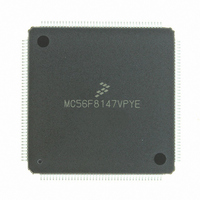MC56F8147VPYE Freescale Semiconductor, MC56F8147VPYE Datasheet - Page 118

MC56F8147VPYE
Manufacturer Part Number
MC56F8147VPYE
Description
IC DSP 16BIT 40MHZ 160-LQFP
Manufacturer
Freescale Semiconductor
Series
56F8xxxr
Datasheet
1.MC56F8147VPYE.pdf
(172 pages)
Specifications of MC56F8147VPYE
Core Processor
56800
Core Size
16-Bit
Speed
40MHz
Connectivity
EBI/EMI, SCI, SPI
Peripherals
POR, PWM, WDT
Number Of I /o
76
Program Memory Size
128KB (64K x 16)
Program Memory Type
FLASH
Ram Size
4K x 16
Voltage - Supply (vcc/vdd)
2.25 V ~ 3.6 V
Data Converters
A/D 16x12b
Oscillator Type
External
Operating Temperature
-40°C ~ 105°C
Package / Case
160-LQFP
Data Bus Width
16 bit
Processor Series
MC56F81xx
Core
56800E
Data Ram Size
4 KB
Interface Type
SPI, SCI, CAN
Maximum Clock Frequency
40 MHz
Number Of Programmable I/os
76
Number Of Timers
2
Maximum Operating Temperature
+ 105 C
Mounting Style
SMD/SMT
Minimum Operating Temperature
- 40 C
On-chip Adc
4 x 12 bit, 4 Channel
Lead Free Status / RoHS Status
Lead free / RoHS Compliant
Eeprom Size
-
Lead Free Status / Rohs Status
Lead free / RoHS Compliant
Available stocks
Company
Part Number
Manufacturer
Quantity
Price
Company:
Part Number:
MC56F8147VPYE
Manufacturer:
FREESCAL
Quantity:
253
Company:
Part Number:
MC56F8147VPYE
Manufacturer:
Freescale Semiconductor
Quantity:
10 000
6.5.10.2
This field represents the lower 16 address bits of the “hard coded” I/O short address.
6.6 Clock Generation Overview
The SIM uses an internal master clock from the OCCS (CLKGEN) module to produce the peripheral and
system (core and memory) clocks. The maximum master clock frequency is 120MHz. Peripheral and
system clocks are generated at half the master clock frequency and therefore at a maximum 60MHz. The
SIM provides power modes (Stop, Wait) and clock enables (SIM_PCE register, CLK_DIS, ONCE_EBL)
to control which clocks are in operation. The OCCS, power modes, and clock enables provide a flexible
means to manage power consumption.
Power utilization can be minimized in several ways. In the OCCS, crystal oscillator, and PLL may be shut
down when not in use. When the PLL is in use, its prescaler and postscaler can be used to limit PLL and
master clock frequency. Power modes permit system and/or peripheral clocks to be disabled when unused.
Clock enables provide the means to disable individual clocks. Some peripherals provide further controls
to disable unused subfunctions. Refer to
Peripheral User Manual for further details.
6.7 Power-Down Modes Overview
The 56F8347/56F8147 operate in one of three power-down modes, as shown in
118
Run
Wait
Stop
Base + $E
RESET
Write
Read
Mode
Input/Output Short Address Low (ISAL[21:6])—Bit 15–0
Figure 6-15 I/O Short Address Location Low Register (SIM_ISAL)
15
1
Active
Core and memory
clocks disabled
System clocks continue to be generated in
the SIM, but most are gated prior to
reaching memory, core and peripherals.
Core Clocks
14
Table 6-3 Clock Operation in Power-Down Modes
1
13
1
12
1
Active
Active
Peripheral Clocks
56F8347 Technical Data, Rev.11
11
1
Part 3 On-Chip Clock Synthesis
10
1
9
1
8
1
ISAL[21:6]
Device is fully functional
Peripherals are active and can produce interrupts if
they have not been masked off.
Interrupts will cause the core to come out of its
suspended state and resume normal operation.
Typically used for power-conscious applications.
The only possible recoveries from Stop mode are:
1. CAN traffic (1st message will be lost)
2. Non-clocked interrupts
3. COP reset
4. External reset
5. Power-on reset
7
1
6
1
5
1
Description
4
1
(OCCS), and the 56F8300
Table 6-3
3
1
Freescale Semiconductor
2
1
.
1
1
Preliminary
0
1











